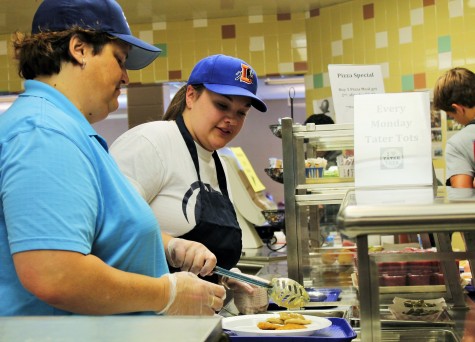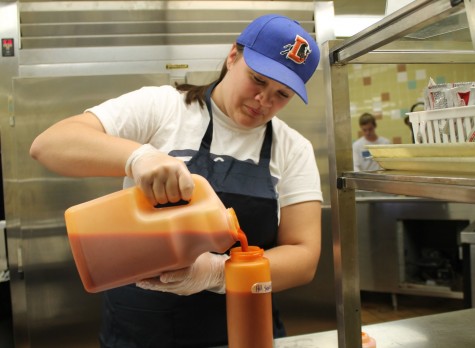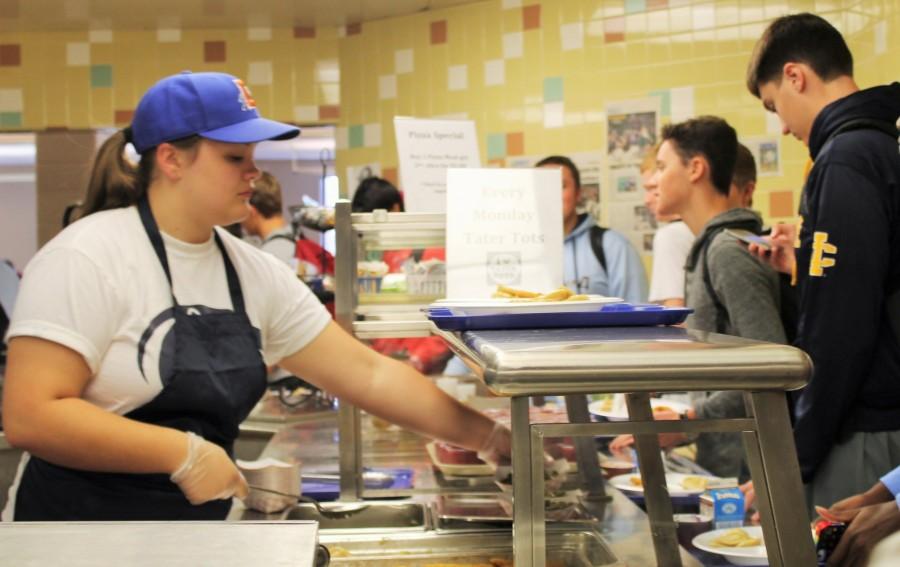Lunchtime and long lines: my day as a cafeteria worker
I spent four periods of my day in the cafeteria serving food to students. While serving, I noticed that most of them would not look up from their phones. Instead, they would just grab a tray and move on.
There’s no word other than overwhelming to describe the feeling that comes over a person when a herd of hungry high school students starts forming long lines in the cafeteria.
I experienced this firsthand, for I had the opportunity to see the cafeteria from the other side of the lunch line. Instead of being served lunch, I was serving lunch to my peers.
I discovered that the North Penn High School cafeteria can be best described as organized chaos because workers are constantly moving around trying to do their job as fast and efficiently as possible. Standing around is a rarity in that kitchen because there is always something to do, from filling to cleaning, from the start of lunches to the end.
Willa Walters, a NPHS food service employee, understands the importance of their routine, saying that “it’s all a puzzle that comes together in the end. Everyone just has to do their job.”

As Bonnie Carter, a NPSD substitute cafeteria worker, put the chicken tenders on the tray, I scooped six pierogies on to the tray. I also served the green beans to the students upon request.
At the start of the school day, only a handful of cafeteria employees are in the kitchen, including Carol Begley, manager of the NPHS kitchen. Begley oversees the cafeteria from breakfast to lunch, assuring that everything is prepared for the colossal amount of students.
Third period, before the lunchtime rush, more employees arrive for their shift, and then it’s all hands on deck. Someone is preparing the food, someone is stocking the juices and milks, someone is stacking trays, and overall everyone is doing something to help out.
Throughout my time in the kitchen, Bonnie Carter, one of North Penn School District’s substitute cafeteria workers, acted as my mentor as we worked as a team to provide lunch to the students. While she managed the chicken tenders, my job was to scoop exactly six pierogies onto each tray and at the same time keep track of the green beans.
To me, this tasked seemed pretty manageable since I have experience from my time working behind the deli at WaWa. I figured that if I could handle the summertime Saturday lunch rush, then I could handle this responsibility.
Once the students started to roll in for lunch, though, it was a whole other story.
The trays that were already prepared were quickly whisked away and I was facing an ever growing line of teenagers. Suddenly, I felt like I wasn’t moving fast enough.
Carter assured me though that I would “get used to the fast paced environment soon enough,” but I still felt like everything just kept moving.
After the first lunch period, I thought I would have a second to catch my breath, but it was quite the opposite. I was instructed to prep as much as I could before the next lunch, so instead of standing around, I was filling the food and running trays to the back.
Soon enough, it was then time for the next rush of students, and the process began all over again.
As each period went by, I found myself getting used to my role in the kitchen; however, by no means did the job get much easier.
I was indeed stressed out because I constantly felt like I was holding up the line. But, there was always someone around to help me out because even though all workers have assigned roles, everyone was always asking around to see if I needed anything.

In between lunch periods, workers would be prepping the cafeteria for the next lunch. The list of preparations included stacking trays, wiping the counter, and refilling the hot sauce.
The whole staff was genuinely nice to one another, so it overall created a positive workplace. Even though the work was not the most fun, my temporary co-workers definitely made the job more enjoyable.
By the time all of the students were fed, I was hot, sweaty, and tired. I could not even begin to imagine what it is like managing that line alone because I discovered that it definitely requires some intense concentration and skill.
I could not wait to sit down, but my day was not over quite yet. The final part of my job was cleaning up the kitchen so that it was ready for the next day.
As I washed the counters and swept the floors, the only thing that I could think was that teenagers are very messy. It took me about fifteen minutes to sweep just my side of the lunch line because there were French fries and bent silverware scattered all over the place.
According to the cafeteria staff, the line is left messy almost every day. Most students just are not mindful when going through the line, so if something drops, they have no clue. Other students, however, intentionally make a mess, especially with the bent silverware, in an effort to be funny.
“Most students are not appreciative of the work that gets done back here,” said Begley, who has witnessed rowdy students in lunch line before.
Whether or not it’s intentional, it’s the cafeteria staff who are left to clean up the students’ messes. Students need to be more aware and respectful when going through the lunch line because, overall, it is just not fair to the staff. If anything, the students should be making their job easier,not harder.
Going into this, I was not sure what to expect from the position or the students. I was surprised to find out that most students are not disrespectful when going through the line but rather oblivious.
“The [students] are usually more interested in what’s on their phone or in their earbuds than what I am serving,” said Carter.
This was made obvious from behind the counter because the common trend among the students was to grab a tray without making eye contact or saying ‘please’, ‘thank you’, or ‘have a good day’. It was annoying to witness this because I experienced firsthand how hard everyone works to make the lunch happen. I know that the workers deserve more than nothing from the students.
Not every student contributed to this trend, however; in each lunch there were a handful of appreciative students.
If more students had the opportunity to witness all of the hard work that is put in behind the scenes on a daily basis in order to make lunch possible, then there would most definitely be a new found appreciation for the cafeteria staff.
But, students should not need to see the work in order to be appreciative. All students that pass through the lunch line should automatically smile or say ‘hello’ to the workers because any support from the students helps the staff help each other. I can assure that it will make their day just a little bit better.



Lisa Smolinsky • Oct 21, 2015 at 11:31 am
What a wonderful story. It is definitely harder than they make it look. I think it is a great experience to see how truly hard all the cafeteria staff work in NPSD!